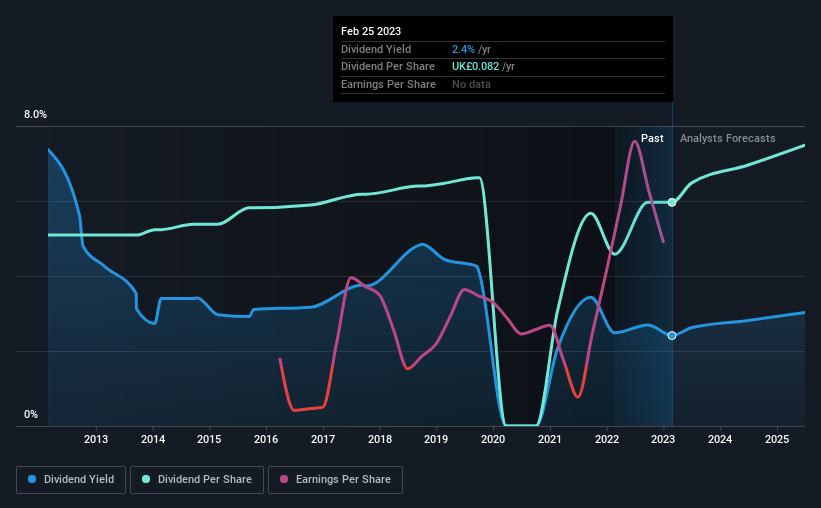- United Kingdom
- /
- Professional Services
- /
- LSE:WIL
Wilmington plc (LON:WIL) Looks Like A Good Stock, And It's Going Ex-Dividend Soon

Readers hoping to buy Wilmington plc (LON:WIL) for its dividend will need to make their move shortly, as the stock is about to trade ex-dividend. The ex-dividend date is one business day before a company's record date, which is the date on which the company determines which shareholders are entitled to receive a dividend. The ex-dividend date is important as the process of settlement involves two full business days. So if you miss that date, you would not show up on the company's books on the record date. This means that investors who purchase Wilmington's shares on or after the 2nd of March will not receive the dividend, which will be paid on the 6th of April.
The company's next dividend payment will be UK£0.027 per share. Last year, in total, the company distributed UK£0.082 to shareholders. Calculating the last year's worth of payments shows that Wilmington has a trailing yield of 2.4% on the current share price of £3.4. If you buy this business for its dividend, you should have an idea of whether Wilmington's dividend is reliable and sustainable. So we need to check whether the dividend payments are covered, and if earnings are growing.
View our latest analysis for Wilmington
Dividends are typically paid from company earnings. If a company pays more in dividends than it earned in profit, then the dividend could be unsustainable. That's why it's good to see Wilmington paying out a modest 41% of its earnings. Yet cash flows are even more important than profits for assessing a dividend, so we need to see if the company generated enough cash to pay its distribution. It distributed 39% of its free cash flow as dividends, a comfortable payout level for most companies.
It's encouraging to see that the dividend is covered by both profit and cash flow. This generally suggests the dividend is sustainable, as long as earnings don't drop precipitously.
Click here to see the company's payout ratio, plus analyst estimates of its future dividends.

Have Earnings And Dividends Been Growing?
Companies with consistently growing earnings per share generally make the best dividend stocks, as they usually find it easier to grow dividends per share. If earnings decline and the company is forced to cut its dividend, investors could watch the value of their investment go up in smoke. This is why it's a relief to see Wilmington earnings per share are up 7.1% per annum over the last five years. Management have been reinvested more than half of the company's earnings within the business, and the company has been able to grow earnings with this retained capital. Organisations that reinvest heavily in themselves typically get stronger over time, which can bring attractive benefits such as stronger earnings and dividends.
The main way most investors will assess a company's dividend prospects is by checking the historical rate of dividend growth. Wilmington has delivered 1.6% dividend growth per year on average over the past 10 years.
The Bottom Line
From a dividend perspective, should investors buy or avoid Wilmington? Earnings per share growth has been growing somewhat, and Wilmington is paying out less than half its earnings and cash flow as dividends. This is interesting for a few reasons, as it suggests management may be reinvesting heavily in the business, but it also provides room to increase the dividend in time. We would prefer to see earnings growing faster, but the best dividend stocks over the long term typically combine significant earnings per share growth with a low payout ratio, and Wilmington is halfway there. Overall we think this is an attractive combination and worthy of further research.
On that note, you'll want to research what risks Wilmington is facing. Every company has risks, and we've spotted 1 warning sign for Wilmington you should know about.
If you're in the market for strong dividend payers, we recommend checking our selection of top dividend stocks.
Valuation is complex, but we're here to simplify it.
Discover if Wilmington might be undervalued or overvalued with our detailed analysis, featuring fair value estimates, potential risks, dividends, insider trades, and its financial condition.
Access Free AnalysisHave feedback on this article? Concerned about the content? Get in touch with us directly. Alternatively, email editorial-team (at) simplywallst.com.
This article by Simply Wall St is general in nature. We provide commentary based on historical data and analyst forecasts only using an unbiased methodology and our articles are not intended to be financial advice. It does not constitute a recommendation to buy or sell any stock, and does not take account of your objectives, or your financial situation. We aim to bring you long-term focused analysis driven by fundamental data. Note that our analysis may not factor in the latest price-sensitive company announcements or qualitative material. Simply Wall St has no position in any stocks mentioned.
About LSE:WIL
Wilmington
Provides data, information, training, and education solutions to professional markets in the United Kingdom, the United States, rest of Europe, and internationally.
Flawless balance sheet, undervalued and pays a dividend.
Similar Companies
Market Insights
Community Narratives



